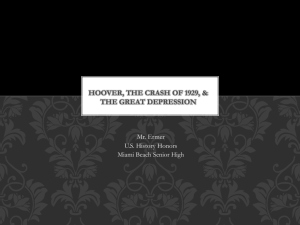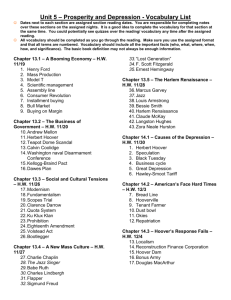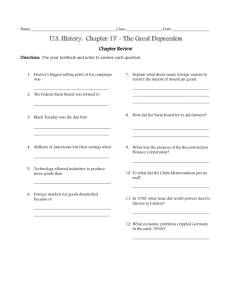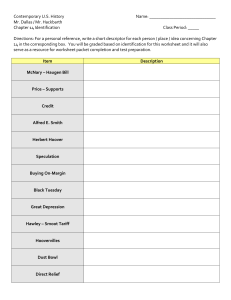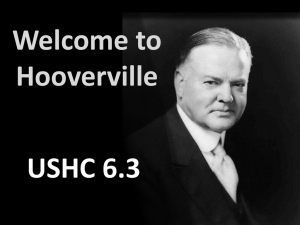Herbert Hoover and The Great Depression
advertisement
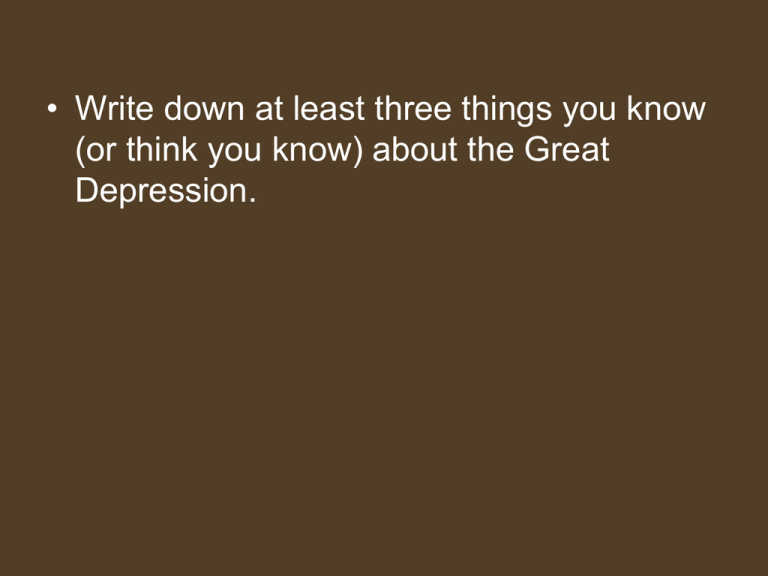
• Write down at least three things you know (or think you know) about the Great Depression. • Bread Line • Stock Market Crash • Herbert Hoover Dust Bowl Okies • Hooverville • Hoover Flag • Franklin Delano Roosevelt (FDR) • The New Deal Herbert Hoover and The Great Depression 1928-1932 Herbert Hoover • World famous for organizing relief of Europe after WWI. • Was Sec. of Commerce under Harding and Coolidge. • Ran for Pres. In 1928 as the Republican nominee vs. Al Smith (the first Catholic to run for Pres. & Smith was also a “wet”). • Hoover won in a landslide (although Smith won most of the big cities). What Hoover Was For • Hoover had been an orphan who worked hard and eventually went to Stanford. • He made millions as a mining engineer. • He believed in “rugged individualism.” • Rugged Individualism = If the govt. stayed out of the way, individuals could succeed through hard work. • He was not as conservative as Harding or Coolidge but still believed in a limited Govt. • “A chicken in every pot.” The Stock Market Crash • During the 1920s, many investors bought stocks on margin. – The customer only put 5% down and borrowed the rest from the broker. – The broker financed the loans by borrowing from banks. – The banks loaned $ from their customers accounts. – THE PRICES ONLY STAY HIGH AS LONG AS INVESTORS KEEP PUTTING $ INTO THE MARKET. – OPEN BOOK TO PAGE 419. • Speculation drove the prices of stocks up artificially. • Some investors began to sell their stocks and prices began to drop. • Brokers began calling in their margins which many people could not pay. • Brokers than started to sell large amounts of stock to recoup their loses. • This caused a Panic. Review • 1. Explain buying stocks on “margin” and how this led to the stock market crash. • 2. What year did the stock market crash? • • • • A = 1929 3. Who was President when the stock market crashed? A = Herbert Hoover 4. What was the name of Hoover’s political philosophy and what did it mean? • A = “Rugged Individualism” • 5. What was historic about the 1928 election? • A = 1st in which ha Catholic ran (Al Smith—he lost to Hoover). Black Tuesday • Tuesday, October 29, 1929 was what many have called, “the most devastating day in the history of markets.” • This was the day that began the panic— people trying to unload their stocks. • When it (the Crash) was all over, over $30-billion in stock value was wiped out. Bank Failures • When the brokers couldn’t re-pay the $ they had borrowed from the banks, the banks couldn’t give money to all of their customers. • Soon more and more people began demanding their $ from banks at the same time and this caused banks to fail (go out of business). • When a bank goes under, people loose their $. • By 1933, more than 9,000 banks had closed. Bank Failures 4500 4000 3500 3000 2500 2000 1500 1000 500 1944 1942 1940 1938 1936 1934 1932 1930 1928 1926 1924 1922 0 Stock Market Crash did NOT cause the Great Depression • 1. Overproduction—too many goods =Depressed farms and industry. And as people earn less (or loose their jobs), they have less $ to buy things. • 2. Unequal Wealth Distribution —Still a lot of poor people which meant that they can’t buy goods. • 3. Govt. chose restrictive monetary policy —high interest rates and curtailed the amount of money in circulation. • 4. Decline in Foreign Trade —High tariffs and no loans to foreign countries meant that those countries couldn’t buy American goods. . Go to Hoover’s Response and the Okies Causes of Great Depression • 1. Lack of Diversification —Construction & Automobiles. • 2. Unequal distribution of wealth=imbalance between supply and demand (overproduction). • 3. Credit structure of economy —Farmer’s debts & investment in stock market & too many people buying on creidt what they could not afford. • • • • 4. A. B. C. Declining Exports: High tariffs (Smoot-Hawley Tariff). Less demand European financial difficulties. • 5. International Debt Structure — Countries like Germany needed more loans to pay of war reparations. Federal Reserve Board’s Response • Raised interest rates in 1931. • = less money in circulation. • Severe Contraction.
